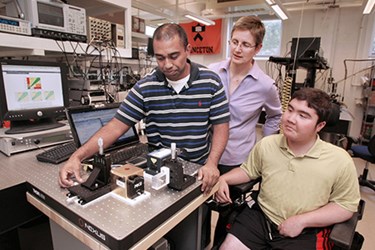Laser-Based Diabetes Testing, No Blood Required
By Chuck Seegert, Ph.D.

Every day, millions of diabetics measure their blood glucose levels by pricking themselves to get a blood sample, but thanks to a new advance from Princeton researchers, this may not be necessary for much longer.
Part of a diabetic’s daily life consists of obtaining blood to test for sugar levels. Typically, this is done via a small pin prick on the finger, which may not seem like an onerous burden. But, when it is required several times a day, it can take its toll on quality of life.
"We are working hard to turn engineering solutions into useful tools for people to use in their daily lives," said Claire Gmachle, the Eugene Higgins Professor of Electrical Engineering and the project's senior researcher, in a recent press release. "With this work we hope to improve the lives of many diabetes sufferers who depend on frequent blood glucose monitoring."
To make this advance, the Princeton team turned to a laser-based approach that shines light on the patient’s palm, interacting with sugar molecules in the tissue. The light isn’t strong enough to damage the cells, and it is a wavelength that doesn’t interact with water, one of the main components of tissue.
The team’s research is described in more detail in a paper published in Biomedical Optics Express. The specific type of laser they used was a mid-infrared laser, which is different from the more common near-infrared lasers used in many other applications. This frequency allows for the measurement of sugar in the dermal interstitial fluid, which is strongly correlated with blood sugar.
Producing mid-infrared energy is somewhat challenging, however, and the team needed to use quantum cascade laser systems, which are tunable to many frequencies. Initial prototypes were rather large, taking up most of a workbench, but with some advances in cooling, the system became much smaller.
"This summer, we are working to get the system on a mobile platform to take it places such as clinics to get more measurements," said Sabbir Liakat, the paper’s lead author, in the press release. "We are looking for a larger dataset of measurements to work with."
According the research article, the system was tested on 3 subjects after each had consumed 20 jellybeans. Apparently, this is a standard method for increasing blood glucose in human subjects. Initial test results indicated that the laser-based method had a greater variability than existing methods, but was well within the clinical requirement for accuracy — within 20 percent of the actual blood sugar.
Non-invasive, light-based diagnostics are increasingly in demand, and the research and development community is responding to this need. In addition to blood sugar levels, there have been recent advances in the dermatology space using optical measurements to diagnose skin lesions.
Image Credit: Frank Wojciechowski
